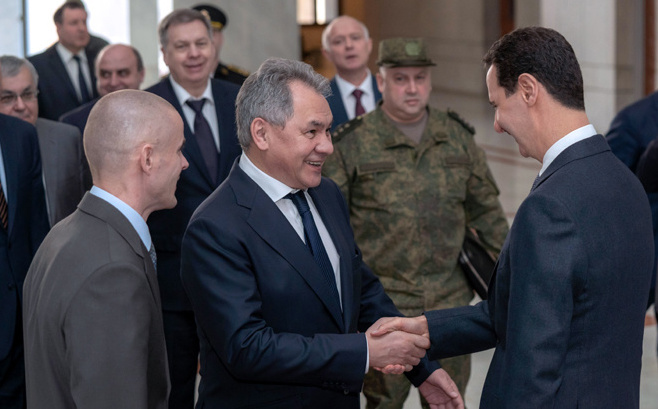Bashar al-Assad greets Russian Defense Minister Sergey Shoygu, Damascus, Syria, March 19, 2019
Russia has marked the fifth anniversary of its military intervention to save Syria’s Assad regime.
Defense Minister Sergey Shoygu hailed the air and ground operations to rescue the regime’s depleted military after anti-Assad forces took much of northwest and southern Syria, with a Kurdish authority establishing an autonomous zone in the northeast.
Sometimes, in the course of ongoing discussions, a question arises whether Russia did the right thing to assume this difficult task. But every time there are all grounds to say: the mission in Syria was necessary and the decision to start the military operation was correct, maybe it was even the only option.
But Shoygu was deceptive in portraying the intervention’s primary focus as the defeat of the Islamic State, which at one point controlled one-third of Syria. Instead, more than 80% of Russian airstrikes were on opposition territory, with thousands of civilians killed and the decimation of infrastructure such as hospitals.
The relentless bombing and sieges, as well as Russian special forces and ground advisors, prevented further loss of regime territory. Russian-enabled offensives then surrounded, besieged, and reoccupied the eastern part of Aleppo, Syria’s largest city, in December 2016. Further assaults reclaimed all of southern Syria by July 2018, and parts of the northwest between April 2019 and March 2020.
Shoygu did not mention the threat to the regime in summer 2015, which prompted discussions between Moscow and Iran, led by military commander Gen. Qassem Soleimani, over intervention.
Instead, he declared, “At some point, it became clear that this force [the Islamic State] poses a direct threat not only to the entire region, but to the whole world, including Russia. It was an organization that planned to force the entire humanity obey its rules.”
He continued, “The Islamic State international terrorist organization ceased to exist in Syria, none of the terrorists managed to find his way into Russia.”
The Defense Minister covered up the political and military with the label “terrorist”, and did not mention the role of Iranian forces, Iranian-led foreign militia, and Hezbollah:
With the support of the Russian aviation, Syria’s armed forces liberated 1,024 populated areas from terrorists. As a result, the government troops and self-defense forces regained control over 88% of the country’s territory.
Shoygu boasted that “more than 133,000 terrorists” have been killed and “133,542 terrorist facilities” since September 2015. He did not mention civilian casualties or the bombing of hospitals — decimating the medical system in much of Syria — markets, schools, infrastructure, and other public sites.
See Syria Daily, May 12: Amnesty — The Russia-Regime “War Crimes” v. Schools and Hospitals
Instead, he said that the military operations had “demonstrated Russia’s capacity to successfully defend its national interests in any location of the planet and its readiness to provide military support to its allies and partners”, strengthening Moscow’s position in the international arena and thwarting attempts by rivals “to isolate Russia politically and diplomatically”.

